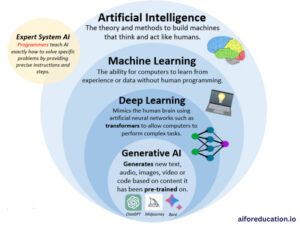Artificial intelligence (AI) refers to computer systems capable of performing tasks that historically required human intelligence.
 Generative AI, conversely, can be understood as the “actionable” aspect of AI, where new data can be created to understand and generate human responses rather than using Large Language Models (LLM) to analyze existing data.
Generative AI, conversely, can be understood as the “actionable” aspect of AI, where new data can be created to understand and generate human responses rather than using Large Language Models (LLM) to analyze existing data.
Think of generative AI as a highly advanced version of autocomplete or auto-generate functions capable of producing coherent and contextual content.
A brief history of generative AI
While awareness of artificial intelligence (AI) has surged in recent years, its origins trace back to the 1940s with the emergence of programmable digital computers and the introduction of mathematical reasoning concepts.
Generative AI took root in the 1950s through the pioneering work of IT visionaries such as Alan Turing and John McCarthy. Their concepts were remarkably forward-thinking, though the technology required to materialize their ideas fully hadn’t advanced enough. It wasn’t until the 2000s that the technology and the associated field of generative AI progressed to the level we are experiencing today.
Potential of generative AI in healthcare
Generative AI extends well beyond word and image generation. This transformative technology holds the promise of revolutionizing the healthcare landscape as we understand it today.
By training generative AI models on diverse datasets encompassing both structured and unstructured data, the potential exists to generate novel data samples that can enhance the delivery of clinical care significantly.
For example, when properly and responsibly implemented, generative AI can empower medical professionals with insight into a patient’s medical history and treatment plans. Other ways include:
- Giving meaning to structured and unstructured data. With generative AI, the structured data in electronic medical records (EMRs) and other repositories can be combined with unstructured data (medical imaging, physician notes, or written documentation, etc.). When this data is combined, healthcare providers can gain a more holistic view of how improvements can be made that benefit patient outcomes and operational efficiency.
- Large data set analysis. An AI-driven algorithm can analyze vast datasets, potentially leading to early diagnosis and personalization of patient treatment plans.
Ensuring the safe integration of AI in healthcare
Healthcare and security experts are voicing valid concerns regarding this technology, particularly regarding the potential for privacy breaches and the ramifications of threat actors gaining access to LLM technologies.
Like any new technology that’s implemented in a healthcare environment, careful consideration is essential, especially in relation to regulatory compliance, patient privacy, and risks.
When considering integrating generative AI into your healthcare ecosystem, carefully assess these pivotal aspects and follow essential steps to safeguard the safety and security of your organization:
Data privacy and security
- Implement robust data anonymization and de-identification techniques to protect sensitive patient information
- Ensure compliance with relevant data protection regulations, such as HIPAA (United States) or GDPR (European Union)
- Establish strict access controls and audit trails for accessing and processing patient data
- Encrypt data at rest and in transit using industry-standard encryption protocols
Model training and deployment
- Use only de-identified and anonymized patient data to train the generative AI model
- Implement secure model deployment practices, such as containerization, secure communication channels, and regular security updates
- Regularly monitor and audit the model’s outputs for potential biases, errors, or privacy leaks
Ethical guidelines
- Establish clear guidelines and protocols for the appropriate use of generative AI in healthcare scenarios
- Ensure transparency by providing explanations for the model’s outputs and decisions
- Involve healthcare professionals, ethicists, and patient representatives in the development and deployment process.
Risk management and governance
- Conduct thorough risk assessments and develop mitigation strategies for potential risks, such as model misuse, data breaches, or harmful outputs
- Establish a governance framework with clear roles, responsibilities, and oversight mechanisms
- Regularly review and update policies, procedures, and best practices as the technology evolves
User training and awareness
- Provide comprehensive training to healthcare professionals on the proper use, limitations, and potential risks of the generative AI solution
- Raise awareness about the importance of responsible and ethical use of AI in healthcare
- Encourage open communication and feedback channels for users to report concerns or issues
Continuous monitoring and improvement
- Implement robust monitoring and auditing mechanisms to track the performance and behavior of the generative AI solution
- Regularly review and update the model with new data and feedback to improve accuracy and mitigate biases
- Establish processes for promptly addressing any identified issues or vulnerabilities
Collaboration and knowledge sharing
- Collaborate with other healthcare organizations, researchers, and industry experts to share best practices, lessons learned, and address common challenges
- Participate in industry forums, conferences, Roundtables, and working groups to stay updated on the latest developments and regulations
Balancing innovation and healthcare cybersecurity
The integration of generative AI into healthcare is inevitable, offering potential benefits for both patients and providers. AI advancements holds the promise of enhancing personalization, efficiency, and effectiveness. However, its success hinges on robust cybersecurity measures.
Numerous initiatives dedicated to promoting secure AI implementation in healthcare are currently underway. Among these are the Advanced Research Projects Agency for Health (ARPA-H) and the Defense Advanced Research Projects Agency (DARPA).
These endeavors aim to drive the progress of AI-enabled technologies while prioritizing the protection of healthcare providers and the resilience of America’s healthcare system.
As we navigate this new terrain, it’s crucial to prioritize the simultaneous development of AI and cybersecurity, ensuring that advancements in healthcare remain secure, ethical, and patient-centric.
For more insights into artificial intelligence in healthcare and the legislative frameworks being developed around AI, check out our 2024 Horizon Report.


